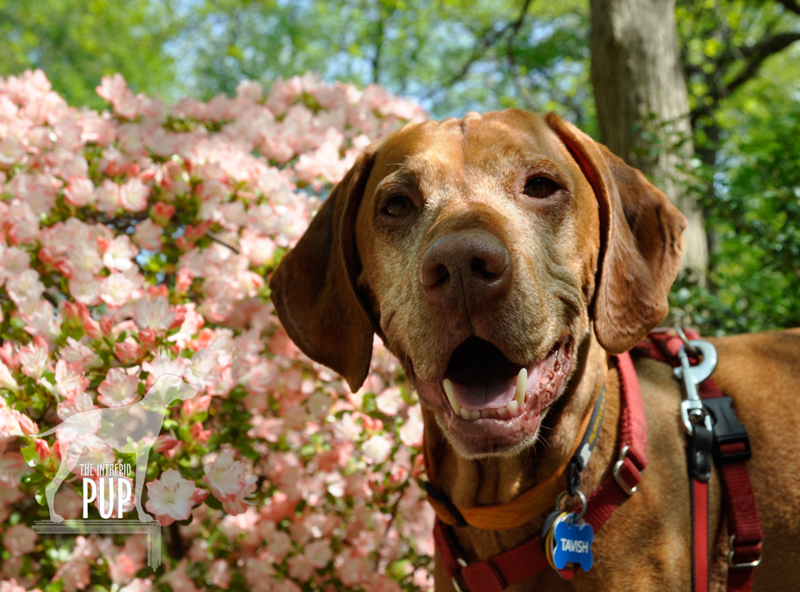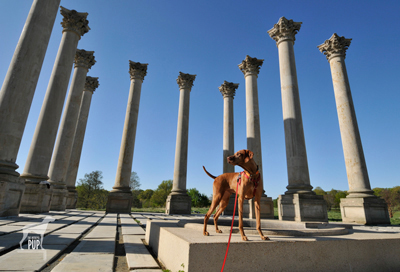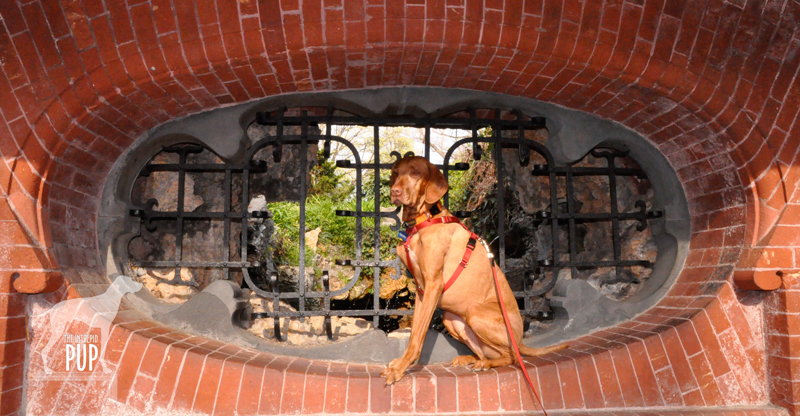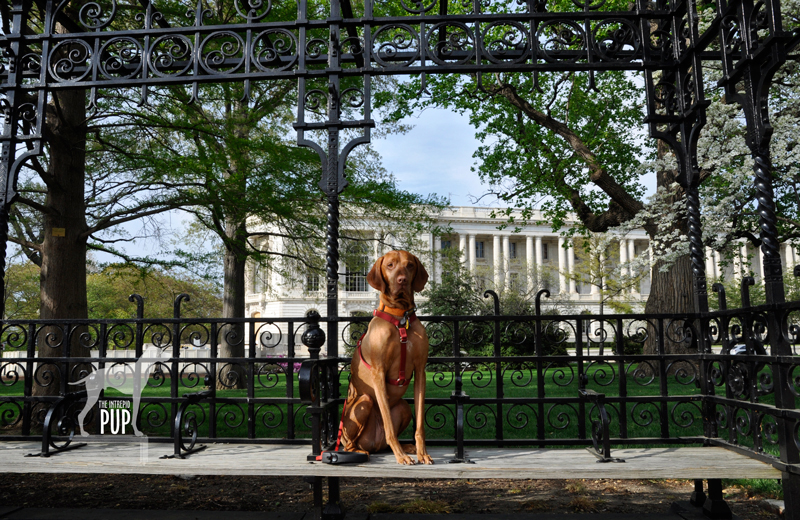
Tavish smiles at the sight of the Arboretum’s azaleas, spanning the color spectrum from to pale pink to deep purple.
Washington, DC’s cherry blossoms are justifiably famous, but don’t be fooled…there’s a rival bloom in town! By late April the cherry trees’ delicate pink petals have long given way to tender green leaves. But a mere 4 ½ miles from the oft-photographed Tidal Basin, some 15,000 azaleas are just reaching their peak at the U. S. National Arboretum.
Established by Congress in 1927, the National Arboretum’s 446 acres are managed by the Agricultural Research Service of the U.S. Department of Agriculture (USDA). And while there’s admittedly way more to the Arboretum than the Azalea Collection, there’s no denying that it sure makes one heck of a first impression. Visit on a sunny spring afternoon, and you’re in for a retina-jarring display of deep magentas, purples, corals, oranges, and ruby reds.

Picture perfect: Tavish, boxwood, and vivid azaleas fill the frame in this shot of the Morrison Garden.
The core of the Azalea Collection is comprised of hybrids that were carefully cultivated at a USDA research facility in Glenn Dale, Maryland, and planted in 1946-47 to blanket the slope of the Arboretum’s Mount Hamilton. Rising just 240 feet, it’s a pretty meager mountain, but as one of the higher elevations in the nation’s capital, Mount Hamilton’s real street cred lies in being a living wall of color. Over the course of more than half a century, the historic Glenn Dale shrubs have matured, sprawling outward and reaching towering heights. A strategic pruning in 2012-13 has rid the area of invasive plants and dead branches, improving growing conditions so that this floral legacy will continue to flourish for years to come.
Tavish the Intrepid Pup visibly enjoys romping along the Henry Mitchell Walk in this section. When he’s not literally snuffling the azaleas, he’s absolutely entranced by the bees methodically inventorying the buds. The casual landscaping that otherwise characterizes much of this hillside is punctuated by two garden settings. The Lee Garden features Japanese azaleas set amidst stonework and a pond, and the compact Morrison Garden is even more formal with manicured ornamental hedges interspersed with samples of the Glenn Dale hybrids. The latter was designed by Benjamin Morrison who was not only the Arboretum’s first director but also the USDA plant breeder responsible for creating the Azalea Collection. Take note: the Morrison Garden seems to be a magnet for folks wanting to take pictures of families, babies, and dogs—and we were no exception!
Dogging the Details
38°54′30.65″ N, 76°58′18.95″ W
U. S. National Arboretum, Washington, DC
With free admission, 9.5 miles of roadways and 14 distinct garden “collections,” the Arboretum is ideal for exploring with a canine companion, and you’re bound to see several other dogs during your visit. Just be sure to abide by the rules: you must keep your dog on leash and out of the plantings. You’re also required to pick up after your pet, so bring those bags along. Finally, no dogs are allowed in either the visitor center pavilion or its adjacent National Bonsai & Penjing Museum.

These koi aren’t coy! Tavish is mesmerized by these guys. And with good reason: the largest are upwards of 18″ in length! A nearby coin-operated machine dispenses handfuls of pellets for feeding the fish, and boy, do they know it. The koi charge to the surface in a burst of color and nearly launch themselves onto the patio!
Note: The ornamental pond surrounding the Administration Building is being restored in 2013, so the fish aren’t there at the moment. Look for them to return when renovations are complete.
The Arboretum scores a “1” on the Intrepid Pup wag-a-meter as a truly accessible place for all seasons. Crocus, daffodils, magnolias, redbuds, and flowering cherries greet spring visitors. Summer gives way to water lilies, herbs, crapemyrtle, and wildflowers. Hosta, hibiscus, and ornamental grasses are the stars of autumn, and winter showcases holly and the conifers.
Though trails and roads are well-marked, it’s easy to lose track of time and distance at the Arboretum. Even the most casual of wanderings will quickly add up to a few miles, so be sure to carry water for you and your dog and/or seek out the bubbler by the National Herb Garden—it has a pet-accessible reservoir and a special tap for refilling water bottles. When the capital’s infamous humidity hits, head for the grass and shade of the National Grove of State Trees. Tavish never fails to take a breather beneath the boughs of the eastern white pine that is the official tree of his home state of Maine. Another refreshingly cool spot just beyond the grove is Fern Valley, a naturally wooded area rife with native plants. A half-mile trail loops through a meadow and past a small pond.

Veni, vidi, vici! Tavish surveys the National Arboretum’s sweeping landscape from the vantage point of the Capitol Columns.
Bring your camera to zoom in on the blooms, but go for the wide angle shots, too. The Capitol Columns make for a particularly dramatic backdrop. Completed in 1826, these 22 sandstone columns were among the 24 that once supported the east central portico of the U.S. Capitol Building. They’ve witnessed every presidential inauguration from Andrew Jackson’s through Dwight D. Eisenhower’s. Modifications to the Capitol necessitated their removal in 1958. With marble replicas going into the Capitol facade, these columns were subsequently restored and permanently sited at the Arboretum in 1990.




 Yonder’s
Yonder’s 









 Just in time for Presidents’ Day is this week’s
Just in time for Presidents’ Day is this week’s  to U.S. president Gerald Ford from Ford’s daughter and the White House photographer.
to U.S. president Gerald Ford from Ford’s daughter and the White House photographer.
